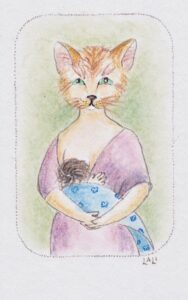“The world is now dominated by an animal that doesn’t think it’s an animal. And the future is being imagined by an animal that doesn’t want to be an animal,” Melanie Challenger writes in her splendid book, How To Be Animal. Humanity has always been united in the belief that, whatever we may be, we are not animals. From Antiquity through the Middle Ages, it was our soul that separated us from other beings. With the Enlightenment, the soul migrated into the brain, and reason and intelligence became what distinguished us from the rest of Creation. This illusion, exacerbated by present-day technology, is at the root of many of our problems, according to Challenger.
But humans don’t start out that way. Think about infants. The sight of a lolloping dog in the park can rouse even the most reserved baby to pointing and vocalizing with an enthusiasm that the sight of a human stranger would never incite. It’s not by chance that we surround our infants with stuffed fauna. One of a child’s first attempts at humor is to pretend to be an animal by barking like a dog or mewing like a cat or mooing like a cow. Or maybe they aren’t pretending. Maybe while making the sounds they really think they are a dog or a cat, until adults inform them that what they are doing is only an act of the imagination.
Then come the years of chapter books—The Wind in the Willows, The Jungle Book, Charlotte’s Web—and of real as opposed to stuffed pets. Ask the oldest person you know about their first dog and watch their face light up as they unspool the story. The drama of that animal’s loss often figures as the first tragedy of their young life. “That dog was my best friend,” they’ll say, their eyes misting, “But it ran away and I never saw it again.”
Slowly and inexorably as we grow up that sense of communion and identification with animals leaves us, and most of us end up like the adults who once told us that we could only pretend we were animals. That was certainly the case for me. I started out as the avid observer and would-be friend of my grandfather’s horses, donkeys, and dogs, of my grandmother’s rabbits and chickens, and of the exotic pets we collected during our years in Ecuador—a macaw, a marmoset, a couple of toucans, a baby ocelot. (It was the 1950s, and we didn’t know what we were doing.) But by the time I was in high school the culture had done its work on me, and I informed a classmate who wanted to become an animal psychologist that that was impossible, because animals don’t have minds.
Still, I never completely lost my early passion for animals, and the obscure sense that I shared aspects of my nature with birds and cats and primates. I was thrilled when an ENT doctor informed me that I had “20% dog hearing,” that is, I could hear 20% of high frequencies that only dogs can hear. And I was proud of my prehensile toes, which I considered a throwback to my simian ancestors and would demonstrate by picking up pencils with my nether digits. (The acute hearing is gone, alas, but the toes still work.)
But it wasn’t until I nursed my daughters that I was jolted into a physical sense that I and the baby in my arms were…mammals. As I felt the milk come in and the baby’s avid guzzling I joined the sisterhood of lactating females, from cats and elephants and bonobos down to the merest mother mouse. I was an animal feeding another animal with a substance produced by my own body. It was such an elemental thing to do, and it brought such contentment that I wanted it to go on and on.
It didn’t, of course. It was the unenlightened 70s, and I was advised to wean my children by six months, when I quickly reverted to my delusions of human grandeur. But I’m grateful for those few months of breastfeeding, which put me in touch with my animal body and the miracles of which it was capable all on its own, without recourse to my rational mind.



2 Responses
Loved this post. Kathleen had a dog almost all of her life, beginning in childhood, mostly German Shepherds. When our last dog, Bain, died, Kathleen’s illness was slowing her down and we knew that another dog was not in our future.
One of the first things we had to do as I was preparing to go overseas in 1969 (Vietnam) was to go to Green Pond SC and get our second dog as a couple, named Anna Pooh. (The first one we got while dating, but it ran away when we lodged it with my parents for a time.) Anna pooh was a great dog and also claimed her spot on Kathleen’s password list, for all the things we need passwords for.
I remember so well Kathleen’s fondness for dogs, especially GSDs, and how she knew exactly how to interact with ours. And I remember you both talking about your beloved Bain.